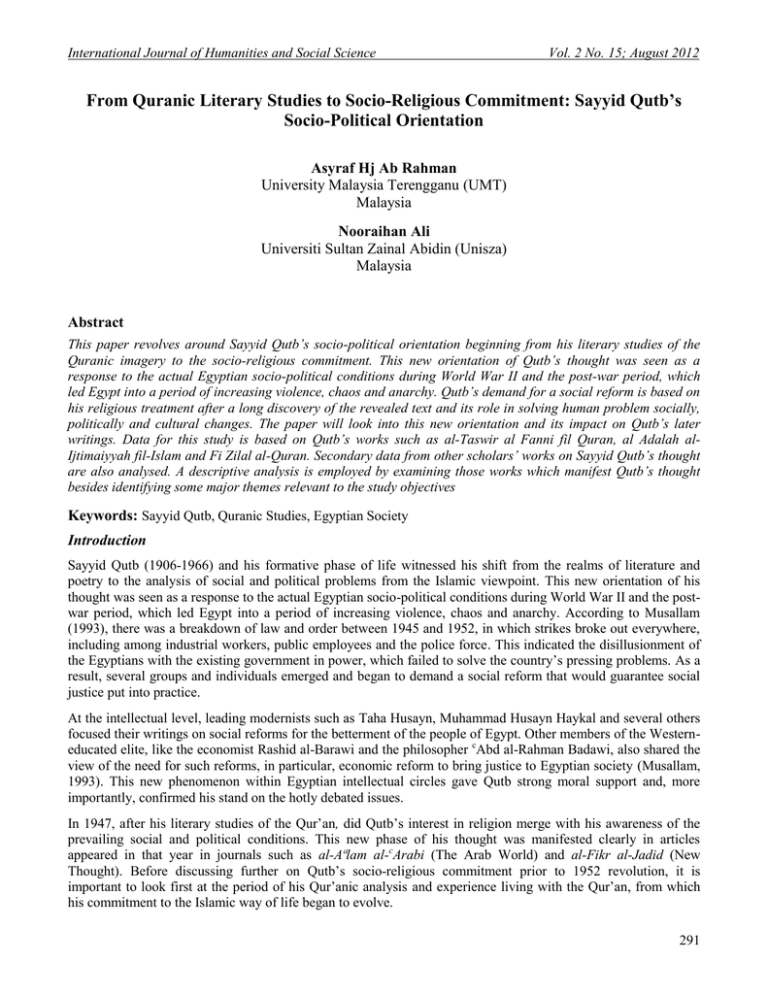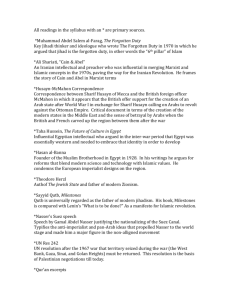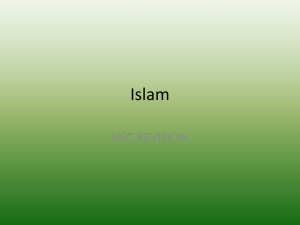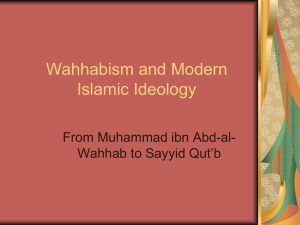Document 10464569
advertisement

International Journal of Humanities and Social Science Vol. 2 No. 15; August 2012 From Quranic Literary Studies to Socio-Religious Commitment: Sayyid Qutb’s Socio-Political Orientation Asyraf Hj Ab Rahman University Malaysia Terengganu (UMT) Malaysia Nooraihan Ali Universiti Sultan Zainal Abidin (Unisza) Malaysia Abstract This paper revolves around Sayyid Qutb’s socio-political orientation beginning from his literary studies of the Quranic imagery to the socio-religious commitment. This new orientation of Qutb’s thought was seen as a response to the actual Egyptian socio-political conditions during World War II and the post-war period, which led Egypt into a period of increasing violence, chaos and anarchy. Qutb’s demand for a social reform is based on his religious treatment after a long discovery of the revealed text and its role in solving human problem socially, politically and cultural changes. The paper will look into this new orientation and its impact on Qutb’s later writings. Data for this study is based on Qutb’s works such as al-Taswir al Fanni fil Quran, al Adalah alIjtimaiyyah fil-Islam and Fi Zilal al-Quran. Secondary data from other scholars’ works on Sayyid Qutb’s thought are also analysed. A descriptive analysis is employed by examining those works which manifest Qutb’s thought besides identifying some major themes relevant to the study objectives Keywords: Sayyid Qutb, Quranic Studies, Egyptian Society Introduction Sayyid Qutb (1906-1966) and his formative phase of life witnessed his shift from the realms of literature and poetry to the analysis of social and political problems from the Islamic viewpoint. This new orientation of his thought was seen as a response to the actual Egyptian socio-political conditions during World War II and the postwar period, which led Egypt into a period of increasing violence, chaos and anarchy. According to Musallam (1993), there was a breakdown of law and order between 1945 and 1952, in which strikes broke out everywhere, including among industrial workers, public employees and the police force. This indicated the disillusionment of the Egyptians with the existing government in power, which failed to solve the country’s pressing problems. As a result, several groups and individuals emerged and began to demand a social reform that would guarantee social justice put into practice. At the intellectual level, leading modernists such as Taha Husayn, Muhammad Husayn Haykal and several others focused their writings on social reforms for the betterment of the people of Egypt. Other members of the Westerneducated elite, like the economist Rashid al-Barawi and the philosopher cAbd al-Rahman Badawi, also shared the view of the need for such reforms, in particular, economic reform to bring justice to Egyptian society (Musallam, 1993). This new phenomenon within Egyptian intellectual circles gave Qutb strong moral support and, more importantly, confirmed his stand on the hotly debated issues. In 1947, after his literary studies of the Qur’an, did Qutb’s interest in religion merge with his awareness of the prevailing social and political conditions. This new phase of his thought was manifested clearly in articles appeared in that year in journals such as al-Aªlam al-cArabi (The Arab World) and al-Fikr al-Jadid (New Thought). Before discussing further on Qutb’s socio-religious commitment prior to 1952 revolution, it is important to look first at the period of his Qur’anic analysis and experience living with the Qur’an, from which his commitment to the Islamic way of life began to evolve. 291 © Centre for Promoting Ideas, USA www.ijhssnet.com Though Qutb’s analysis focused mainly on the literary aspects of the Qur’an, there were some clear hints of the attitude that he later assumed towards Islam. Describing this new orientation in Qutb’s thought, Nettler (1994) and Haddad (1983) noted that the Quranic usages by Qutb was more towards justifying his existing thought and thus putting him in the rank of Muslim thinkers. According to Nettler (1994), ‘the Quran served for Qutb as a court of last resort and the ultimate proof of his ideas’. This idea perhaps was true if one looked at Qutb’s writings and the conditions of Egyptian society of his time. His writings seemed to be a manifestation of the current conditions facing Egyptian people and Muslims in particular. Need to mention, Qutb’s religious awareness was another factor that drove him closer to Islam and became committed to its teachings. Data for this study is based on Qutb’s works such as al Taswir al Fanni fil Quran, al Adalah al Ijtimaiyyah filIslam and Fi Zilal al Quran. Secondary data from other scholars’ works on Sayyid Qutb’s thought are also analysed. A descriptive analysis is employed by examining those works which manifest Qutb’s thought besides identifying some major themes relevant to the study objectives. Literary analysis of the Qur’an Qutb’s renewed interest in the Qur’an was, perhaps, manifest with the publication in 1939 of his earliest article entitled “al-Ta·wir al-Fanni fi’l-Qur’an” in Muqtataf magazine. In the introduction he stated: “The time has come to study the Qur’an as a literary book and to examine it from a completely artistic point of view.” (Samira Fayyad, 1976). Throughout the discussion, Qutb put more emphasis on the literary aspect of the Qur’an without any elaboration on the nature of the Book itself or any other social and political issues. Thus, his aim was to show the elements of beauty in its style so that writers might be influenced by it as Western writers were influenced by the Bible (Samira Fayyad, 1976). According to Khalidi, the seeds of Qutb’s interest in the Qur’an can be dated from his childhood. At that stage Qutb’s mother, Fatima, played an important role in implanting such an interest in him by making him listen carefully to Qur’anic recitations, especially during the month of Ramadhan when a reciter of the Qur’an was invited to their house. It was however during Qutb’s years at the Dar al-cUlum in the 1920s that his particular interest in the literary analysis of the Qur’an developed. This was due to his dissatisfaction with the institution’s method of teaching the Qur’anic exegesis, which, according to him, was devoid of the enjoyment and excitement that he had experienced in his childhood (Khalidi, 1986). Therefore, the question arose in his mind: “Are there two Qur’ans: that of childhood, sweet, easy and exciting, and that of youth, difficult, complicated and dissected? Or is it rather the fault of the methods of interpretation?” With this new idea in mind, Qutb then undertook to study the Qur’an not for the purpose of increasing his knowledge of religious matters but to examine the Qur’an’s artistic imagery. Qutb clearly stated this renewed interest: I have returned to the Qur’an by reading it, but not in the books of exegesis. And I have rediscovered my beloved and beautiful Qur’an, and found [again] my sweet and longing images – images without the original naivety [I attached to them]. I came now to comprehend its purposes and goals. Al-Taswir al-Fanni fil Quran This Qutb’s work on Qur’anic literary appeared as a book in 1945. The book was the result of Qutb’s extensive study of Qur’anic imagery and indicated its author’s maturity in literary criticism. Qutb, however, did not raise questions about the nature of the Qur’an itself; rather, his aim was a purely literary in the sense of describing the elements of beauty in its style of propagating a religious message. More importantly in this book, the seeds of Qutb’s interest in Islam were gradually germinating when he began to discuss how the charm of the Qur’an had successfully influenced people like cUmar al-Khattab to convert to Islam. Qutb wrote in al-Taswir: ...besides the charismatic personality of the Prophet that had a major effect on converting the first followers to Islam like Khadijah, Abu Bakr, cAli and Zayd, we also found that the Qur’an was the decisive factor in the process of conversion or perhaps became one of the important factors in [bringing] those of the early days of Islamic mission (dacwah) into faith…it is undeniable that the charm of the Qur’an has a strong impact in accelerating him [cUmar’s conversion] to Islam. (1993) 292 International Journal of Humanities and Social Science Vol. 2 No. 15; August 2012 In Taswir Qutb discovered that the power of the Qur’an did not lie in a single sentence or expression, but in the whole style and method of conveying its religious message. Qutb cited many examples of the Qur’an’s artistic imagery at its method of personification. This includes verse 18 of Sura 81 (al-Takwir), “wa’l-subh idha tanaffas” (By the morning when it breathes), which, according to him, was an expression of the peaceful quiet life coming from the morning’s breath filling all creatures with activity (Qutb, 1992). Also in verse 40 of Sura 7 (al-Acraf): Verily, those who believe Our revelations and treat them with arrogance, for them the gates of Heaven will not be opened, and they will not enter Paradise until the camel goes through the eye of the needle. Thus do We recompense the sinners. The abstract meaning of the Sura, according to Qutb, gave a sensual image in which the impossibility of the unbelievers entering Heaven was portrayed and likened to the impossibility of a camel entering a needle’s eye (Qutb, 1992). Turning to the Qur’anic outlook on the afterlife, Qutb contended that the Qur’an portrayed the doomsday scenes in a dynamic way and thus greatly affected the human mind. According to him, the artistic portrayal by the Qur’an of the afterlife was indirectly successful in convincing the Arabs to believe in heaven and hell. At this point, Qutb started to consider the ability of the Qur’an to captivate the Arabs, who were renowned for their deep sensitivities and breadth of imagination. He then found that it was the charm of the Qur’anic literature that influenced them to believe in the Book and become Muslims. So, there emerged a new aim in Qutb’s mind: to study the charm of the Qur’an in its role of propagating a religious message. More significant is that Qutb’s new interest in the Qur’an’s artistic inimitability finally enabled him to understand the Book as a belief system and a guide for human life in all its aspects: social, economic and political. This can be seen with the appearance of his first Islamic book, al-cAdala al-Ijtimaciyya fi’l-Islam, two years later in 1949. The book contained more than two hundred verses from the Qur’an to support his Islamic discussion covering all kinds of topics from doctrinal belief to social and economic questions. Thus, there was a clear sign of Qutb’s new orientation after his eight years of devotion to the literary study of the Qur’an. More importantly, the Quran had prepared him with a new intellectual outlook: his interest in Islam as a way of life. Besides al-cAdala, the appearance of Qutb’s other works such as al-Salam al-alami and Macrakat were also a clear indication of his development of thought as he began to put much emphasis on God as the Supreme Power and discuss extensively the concept of balance and integration of the universe, life and humankind. When describing Qutb’s new Islamic orientation and his Qur’anic justification in solving the current sociopolitical problems of his society, Abu Rabic stated: “Qutb’s utilization of the Qur’anic text as aesthetics paves the way for a more general and perhaps imaginative use of the text as an ideological document in the 1950 and 1960s.”(Abu Rabi, 1996) Islamic Solution Qutb’s articles written between 1945 to early 1947 advocated issues related to social, economic and political reform. His objectives during this period were to expose the real situation of the Egyptian society and the need for reforms. None of his calling advocated “Islamic” solutions. Only in October 1947, after his long study of the Qur’an coupled with a consciousness of the national crisis, did he establish, with some friends, a weekly journal, al- Fikr al-Jadid (New Thought). The journal offered Islamic solutions to the social problems facing the country. The journal also attempt to bring people’s attention to Islam instead of following capitalist and communist groups, who were active in spreading their reformative programmes for the Egyptians. Qutb wrote in the journal that the time had come to look to Islam to solve the current problems in a practical and realistic manner, in true harmony with both an Islamic spirit and the contemporary human situation (Musallam, 1983). The journal, however, did not describe in detail the Islamic method of achieving alising justice in human social and economic welfare, such as the obligation to pay zakat etc. Rather, it focused more on a just distribution of wealth in Egypt, relations between landowners and workers, and between employers and employees in regard to wages and working hours (Musallam, 1983). This lack of any comprehensive Islamic solution was perhaps due to the short period of its appearance: it was published for only six months (October 1947 to May 1948) before being closed down owing to martial law being declared prior to the Palestine war. 293 © Centre for Promoting Ideas, USA www.ijhssnet.com Despite its short life, the journal successfully achieved its goals. The reform programmes advocated by the journal opened the minds of the Egyptians to the need to stand up to the privileged elite in their society and demand social justice the distribution of wealth, individual ownership and so on. As Heyworth-Dunne (1950) writes: The journal promised to be one of the most interesting experiments of modern times, as it offered some real contributions by suggesting methods which could be employed for the solution of some of the acute social problems facing the Egyptian today. The editors also made it their duty to show up the real situation amongst the poor, both in the towns and in the country. He (Qutb) and his agents collected a number of detailed reports on the living conditions of their compatriots and published these with photographs. Besides writing books like al-Adalah, Ma’rakat and al Salam al Alami, Qutb began joining the Ikhwan group and participated in its dakwah activities. It was during this stage that he was in close contact with the Free Officers in their intention of overthrowing the monarchy and the liberal nationalist regime. Despite different ideological principles (Socialism versus Islam), the growing crisis in Egyptian politics and the economy had led them to agree to co-operate in the struggle for unity and justice for the Egyptian people. In describing the social and political sphere of Egyptian society after World War II, Mitchell wrote that the crisis in the country grew worse and greatly affected the economic, political, and social life of the Egyptian people. More importantly, it “had manifold consequences for both the momentum and the direction of the national movement.”(Mitchell, 1969) Therefore, “an agreement of sort” was reached later on between the Free Officers and the Ikhwan concerning the latter’s role on the day of the revolution. This agreement “attempted to foresee all the possible contingencies in which a welldisciplined, well-trained civil army could be of use.” The revolution of July 1952 saw Qutb’s emergence as one of its important figures. He played a vital role in influencing the people of the country and gaining their support. According to Mahmud al-Azab, an Egyptian military officer working at Port Said, Qutb played an instrumental role in the preparations. On the eve of the revolution, he commanded those military officers to be fully prepared. While attending the meeting held at Qutb’s house, Mahmud al-Azab found that some of the revolutionary leaders were also there, including Jamal cAbd alNasir. (Khalidi, 1986). In additions to his direct participation in the 1952 revolution, Qutb also wrote books and articles criticizing the corrupt royal government, feudalism and capitalism. This indicated that Qutb tried to implement what he believed as a true struggle as enunciated by his religious teaching; combating injustice in human society and affirmed the capacity of Islam as an appropriate and desirable ideology for the world of the mid-twentieth century. Qutb wrote in Macrakat (1993), for instance: “the deterioration in social conditions from which the masses of Egypt suffer cannot continue indefinitely…This is a fact that should be known by all’’. Conclusion Qutb’s socio-religious thought from 1947 to 1952 paralleled the social and political situation of Egyptian society itself. World War II and the post-war period were major factors that led the country into social, economic and political chaos and anarchy. Qutb, who identified himself with the social and religious concerns of the people, had become extremely disillusioned with the prevailing social ills and political system. His literary study of the Qur’an coupled with his disillusionment gradually compelled him to find in Islam the solution to the current problems. Al-cAdala, Macrakat and al-Salam al-Aªlami were a detailed analysis of these problems from the Islamic viewpoint. Qutb’s main goals in these works were the social and political reform of the country and the establishment of justice. Islam could provide solutions because its treatment of problems was different from that of capitalism and communism. 294 International Journal of Humanities and Social Science Vol. 2 No. 15; August 2012 References Samira Fayyad (1976), The Study of Qutb’s thought and his literature (unpublished Ph.D thesis University of Manchester. Khalidi, Salah Ab al Fattah (1986) Madkhal ila Zilal al-Qur’an (Jeddah: Dar al-Manara. J. Heyworth Dunne (1950), Religion and Political Trends in Modern Egypt Washington D.C. Qutb, Sayyid (1993). Islam and Universal Peace. Indianapolis: American Trust Publications. Qutb, Sayyid (1992), Fi Zilal al Quran. Cairo: Dar al Shuruq. ______ (1993) Nahw Mujtamac Islami . Cairo: Dar al-Shuruq. ______ (1952) al-cAdala al-Ijtimaciyya fi’l-Islam, Cairo: Matbaca Dar al-Kitab al-cArabi. ______ (1982) Khasa’is· al-Tasawwur al-Islami, Beirut: Dar al-Shuruq. ______ (1993)Mashahid al-Qiyama fi’l-Qur’an, Cairo: Dar al-Shuruq. ______ (1993)Macrakat al-Islam wa’l-Ra’smaliyyah, Cairo: Dar al-Shuruq Abu Rabic, Ibrahim M, Intellectual Origins of Islamic Resurgence in the Modern Arab World, Albany: State University of New York Press, 1996. Mitchell. R (1969). The Society of Muslim Brothers. London: Oxford University Press. Ronald Nettler (1994).’A Modern Islamic Confession of faith and Conception of Religion: Sayydi Qutb’s Introduction to tafseer Fi Zilal al Quran’ in British Journal of Middle Eastern Studie.Vol. 21, No. 1, 1994. 102-110. Y.Y. Haddad 91983) ‘The Quranic Justification for an Islamic Revolution: The View of Sayyid Qutb,’ in The Middle East Journal 37, no. 1. 17. 295




